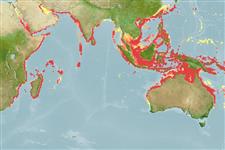>
Eupercaria/misc (Various families in series Eupercaria) >
Haemulidae (Grunts) > Plectorhinchinae
Etymology: Plectorhinchus: Greek, plektos = plaited + Greek, rhyngchos = snout (Ref. 45335).
More on author: Forsskål.
Issue
This species appears to be restricted to southeast Africa to the Arabian Sea, including the Red Sea and Persian Gulf. Junior synonyms Plectorhinchus unicolor (Macleay, 1883) and Plectorhinchus griseus (Cuvier, 1830) are considered valid according to Johnson et al., 2015 (Ref. 103290). Species record and information will be repaired accordingly.
Environment: milieu / climate zone / depth range / distribution range
Ecologia
marinhas; estuarina associadas(os) a recifes; intervalo de profundidade 0 - 80 m (Ref. 9710). Tropical; 30°N - 32°S, 29°E - 160°E
Indo-West Pacific: eastern Africa south to Port St. Johns, South Africa and east to the western Pacific.
Tamanho / Peso / Idade
Maturity: Lm ? range ? - ? cm
Max length : 80.0 cm TL macho/indeterminado; (Ref. 9710); common length : 60.0 cm TL macho/indeterminado; (Ref. 5450)
Found around rocks and corals from the surf zone to a depth of 80 m (Ref. 2799). Enters estuaries and rivers in Seychelles, Madagascar and South Africa (Ref. 2135). Juveniles occur in tide pools (Ref. 9710).
Life cycle and mating behavior
Maturidade | Reprodução | Desova | Ovos | Fecundidade | Larvas
Oviparous, distinct pairing during breeding (Ref. 205).
Masuda, H., K. Amaoka, C. Araga, T. Uyeno and T. Yoshino, 1984. The fishes of the Japanese Archipelago. Vol. 1. Tokai University Press, Tokyo, Japan. 437 p. (text). (Ref. 559)
Categoria na Lista Vermelha da IUCN (Ref. 130435: Version 2024-2)
Ameaça para o homem
Harmless
Utilização humana
Pescarias: espécies comerciais; peixe desportivo: sim
Ferramentas
Relatórios especiais
Descarregue XML
Fontes da internet
Estimates based on models
Preferred temperature (Ref.
123201): 24.3 - 29, mean 27.9 °C (based on 1644 cells).
Phylogenetic diversity index (Ref.
82804): PD
50 = 0.5000 [Uniqueness, from 0.5 = low to 2.0 = high].
Bayesian length-weight: a=0.01413 (0.00689 - 0.02895), b=3.00 (2.83 - 3.17), in cm total length, based on LWR estimates for this Genus-body shape (Ref.
93245).
Nível Trófico (Ref.
69278): 3.8 ±0.49 se; based on food items.
Resiliência (Ref.
120179): Baixo, tempo mínimo de duplicação da população 4,5 - 14 anos (Preliminary K or Fecundity.).
Fishing Vulnerability (Ref.
59153): Moderate to high vulnerability (52 of 100).
Climate Vulnerability (Ref.
125649): High to very high vulnerability (74 of 100).
Nutrients (Ref.
124155): Calcium = 23.7 [8.4, 46.1] mg/100g; Iron = 0.46 [0.24, 0.82] mg/100g; Protein = 19.6 [17.7, 21.4] %; Omega3 = 0.134 [0.074, 0.225] g/100g; Selenium = 39.1 [22.5, 65.7] μg/100g; VitaminA = 58.5 [21.1, 164.2] μg/100g; Zinc = 1.13 [0.78, 1.64] mg/100g (wet weight);
